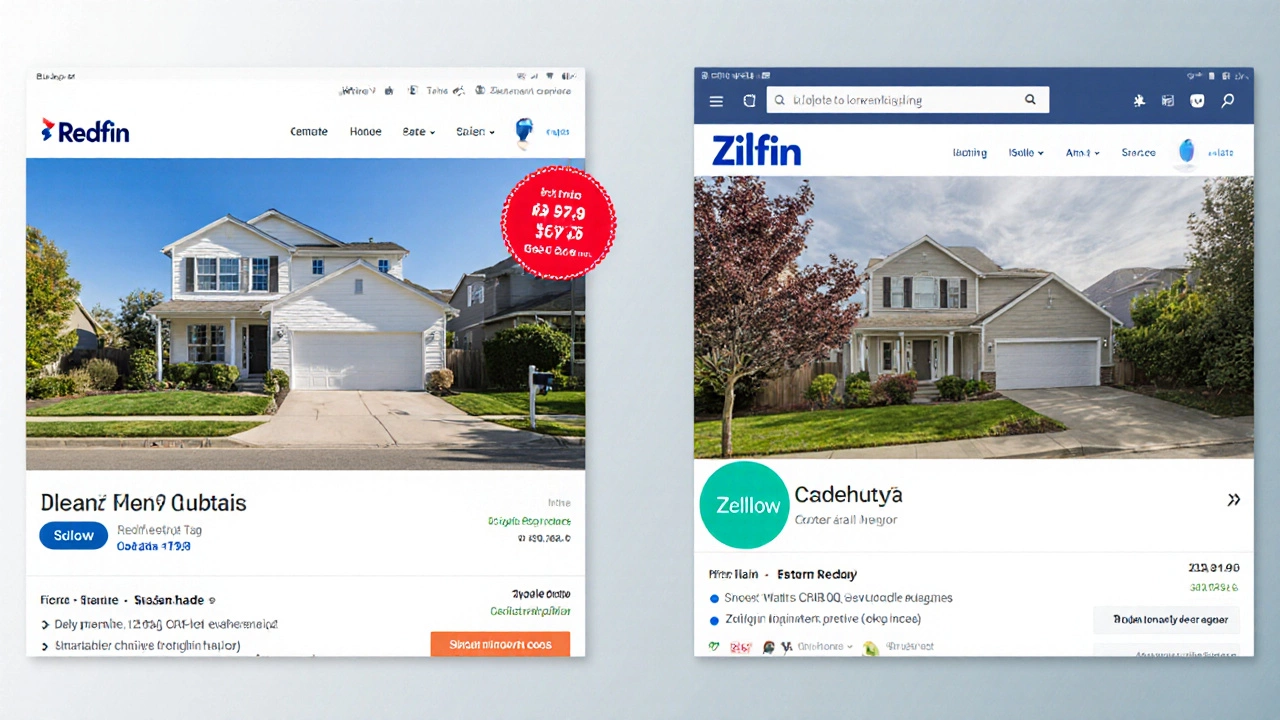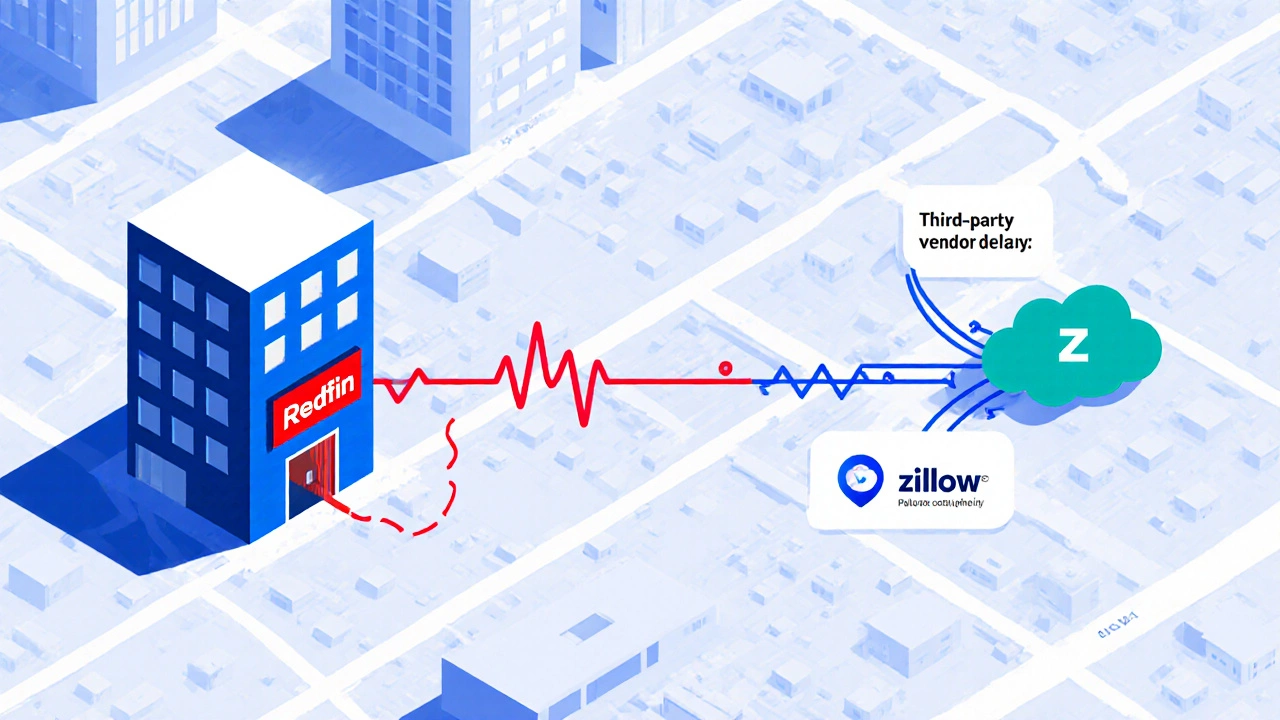Redfin vs Zillow: Why Their Data and Listings Differ

Oct, 9 2025
Redfin vs Zillow Comparison Tool
Redfin
Technology-driven real estate brokerage with direct MLS access in key markets.
Zillow
Largest consumer-facing real estate marketplace with broad geographic coverage.
Data Sources
- MLS Access Direct
- Update Frequency Minutes
- Listing Types Brokered
Data Sources
- MLS Access Syndicated
- Update Frequency Hours
- Listing Types Mixed
Valuation Methods
- Estimate Type Redfin Estimate
- Data Points Less Tax Data
- Accuracy ±4.8%
Valuation Methods
- Estimate Type Zestimate
- Data Points More Tax Data
- Accuracy ±5.6%
Comparison Summary
Redfin Advantages
- More accurate valuations
- Broader inventory in key markets
- Lower commissions
- Real-time updates
Zillow Advantages
- Broader geographic coverage
- More diverse listing sources
- Unique features like Zillow Offers
- Visual tools and maps
Both platforms provide valuable insights. Use them together for comprehensive real estate research.
Key Takeaways
- Redfin and Zillow pull listings from different data feeds, so the same house can appear on one site and not the other.
- Both platforms run separate valuation models - the Zestimate and the Redfin Estimate - which use distinct algorithms and data sources.
- Feature sets (map tools, photo tours, agent connections) cater to slightly different buyer and seller priorities.
- Geographic coverage varies; Redfin focuses on markets where it has a broker presence, while Zillow covers virtually every U.S. ZIP code.
- Cross‑checking both sites, plus recent sales data, gives the most reliable picture of a home’s value.
What Are Redfin and Zillow?
When you search for a home online, the two names you’ll see most often are Redfin - a technology‑driven real‑estate brokerage that also offers a free property search platform - and Zillow - the largest consumer‑facing real‑estate marketplace in the United States. Both sites let you browse listings, see photos, and get an estimate of what a home might be worth, but they were built with different business models in mind.
Where Do Their Listings Come From?
Both Redfin and Zillow rely heavily on the Multiple Listing Service (MLS), the industry‑standard database that real‑estate agents use to share property details. However, the way each site accesses and refreshes MLS data varies.
- Redfin: Operates its own brokerage in more than 80 markets, giving it a direct feed into the MLS for those areas. In markets where Redfin does not have a brokerage, it still receives MLS data through syndicated feeds, but the update frequency can lag by a few hours.
- Zillow: Aggregates MLS data through third‑party data vendors and also accepts user‑submitted listings (known as “Zillow Direct”). Because Zillow does not own brokerages, its MLS feed is broader but can contain older or duplicate entries.
The result? A home listed in a Redfin‑served market will usually appear on Redfin first, while the same property might take longer to show up on Zillow if the MLS feed is delayed or if the listing is submitted directly by the homeowner.

How Do Their Home Valuations Work?
Both platforms boast instant home‑value estimates, but the algorithms behind them differ significantly.
The Zestimate uses a proprietary blend of public records, recent sales, tax assessments, and user‑generated data. Zillow updates the model monthly and incorporates up to 2,000 data points per property.
Redfin’s counterpart, the Redfin Estimate, relies more heavily on actual sale prices and less on tax data. Redfin also factors in its own “home‑sale certainty” score, which reflects the likelihood that a comparable sale truly reflects market conditions.
Because the input data and weighting differ, it’s common to see a 5‑10% gap between the two estimates for the same house. Studies from 2023 show Redfin’s estimates were correct within ±5% on 78% of homes, while Zillow’s were within the same range for 73% of homes - a modest edge for Redfin, but both are far from a substitute for a professional appraisal.
Feature and User‑Experience Differences
If you’ve navigated both sites, you’ll notice distinct design philosophies.
- Search Filters: Redfin provides granular filters for school districts, walk scores, and even day‑of‑the‑week price trends. Zillow offers a broader set of filters, including “home type” and “price range,” but its interface is more visual.
- Map Tools: Redfin’s map overlays median home values and inventory heat maps, useful for investors. Zillow’s map focuses on property boundaries and includes a “3‑D Home” virtual tour for select listings.
- Agent Interaction: Redfin agents are in‑house employees; you can schedule a tour directly through the site and often get a reduced commission. Zillow connects you to independent agents, and the “Zillow Premier Agent” program sometimes adds a lead‑fee cost.
- Mobile Apps: Both apps rank in the top 10 for real‑estate categories on the App Store. Redfin’s app includes a “Hot Homes” alert that pushes notifications for newly listed properties under market value. Zillow’s app features “Zillow Offers,” allowing homeowners to sell directly to the company in certain markets.
Geographic Reach and Market Focus
Redfin’s presence is strongest in metropolitan areas where it operates a brokerage - such as Seattle, San Francisco, and Boston. In these markets, Redfin often has more up‑to‑date data and a larger inventory of “Redfin‑listed” homes.
Zillow, on the other hand, claims coverage of 99% of U.S. ZIP codes. Even in rural counties, Zillow will display a “Zestimate” and a list of nearby homes, though the depth of data may be limited.
For a buyer looking in a city where Redfin has an office, you’ll typically see faster updates and more detailed local market stats. In a less‑served region, Zillow may be the only source with any listing data at all.

Accuracy and Reliability: What the Numbers Say
Several independent analyses compare the two platforms against actual sale prices. A 2024 study by Home Value Index (HVIndex) examined 10,000 homes sold between 2022‑2023. Results showed:
| Metric | Redfin | Zillow |
|---|---|---|
| Median error percentage | 4.8% | 5.6% |
| Listings updated within 24hr | 92% | 85% |
| Homes with both estimates within 5% | 67% | 59% |
While Redfin edges out Zillow on most accuracy metrics, the differences are smaller than many homebuyers expect. The key takeaway is to treat both estimates as starting points, not definitive values.
Practical Tips: Which Site to Trust for Your Situation
- Check both estimates. If they differ by more than 5%, dig deeper into recent comparable sales.
- Verify the listing date. Redfin’s timestamp is often more current in its brokered markets.
- Look at the data source. A “Zillow Direct” listing from a homeowner may lack professional photos or accurate square‑footage.
- Use the agent tools. If you’re ready to tour, schedule through Redfin’s in‑house agents for a quicker response. For broader options, reach out to Zillow Premier Agents.
- Cross‑reference public records. County assessor websites can confirm lot size, year built, and tax assessments, helping you decide which estimate aligns with hard data.
By combining the strengths of both platforms, you’ll get a fuller picture of the market and avoid missing out on a great deal or overpaying for a property.
Frequently Asked Questions
Why does a home sometimes appear on Redfin but not on Zillow?
Redfin may have a direct MLS feed for the market it serves, updating listings within minutes. Zillow often receives the same MLS data through third‑party vendors, which can introduce a delay of several hours or even a day.
Which estimate - Zestimate or Redfin Estimate - is more reliable?
Both are useful, but studies show Redfin’s estimate is slightly more accurate on average (around a 4.8% median error versus 5.6% for Zestimate). Still, use them as guides and verify with recent sales data.
Can I rely on Zillow’s “Zillow Offers” program to sell my house fast?
Zillow Offers works in select markets and can close in as little as a few weeks, but the offer price often sits below the market value. Consider it if speed matters more than maximizing profit.
Do Redfin agents charge a lower commission?
In most Redfin markets, the seller pays a 1.5% commission to Redfin’s in‑house agents, which is lower than the typical 2.5‑3% charged by traditional brokerages.
How can I know if a listing’s data is up to date?
Check the "last updated" timestamp on the property page. Redfin usually displays this information prominently. Zillow may hide it, so you might need to contact the listing agent for confirmation.